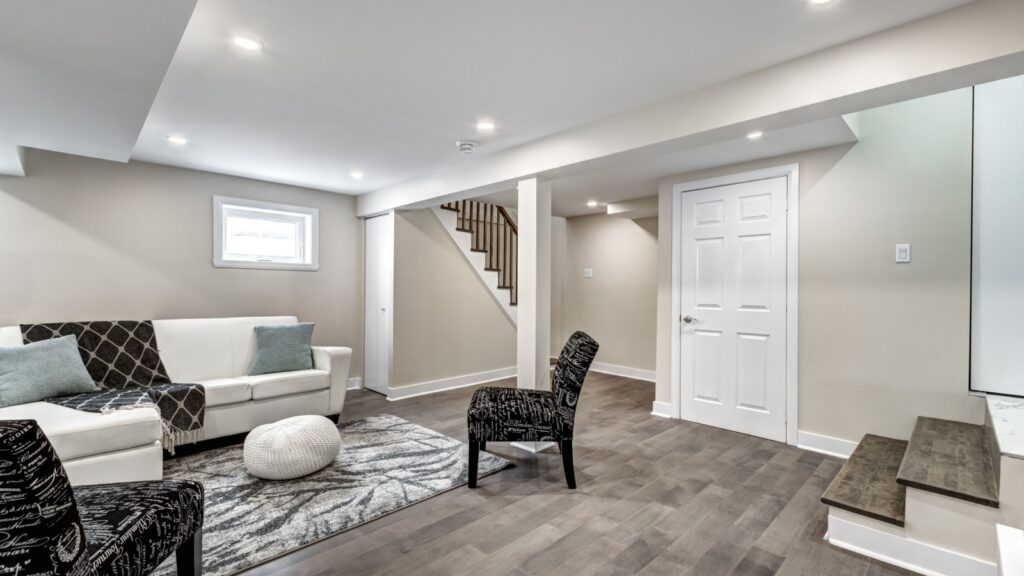A house is no longer just a roof over one’s head—it’s becoming a revenue generator. From basement suites to rooftop gardens, homeowners and renters alike are transforming every square foot into an opportunity. Here are 25 ways Canadians are turning their homes into income.
Renting Out a Basement Suite

Basement apartments are a classic way to generate income, especially in cities where housing is tight. With relatively modest renovations, a homeowner can create a fully functional rental unit complete with a separate entrance, kitchen, and bathroom. Many municipalities encourage “secondary suites” as a solution to housing shortages, making the process easier with pre-approved bylaws. The appeal is twofold: tenants get affordable accommodation, while owners earn passive monthly rent that helps with mortgage payments. Demand is strong, particularly among students, new immigrants, and single professionals.
Listing on Short-Term Rental Platforms

Platforms like Airbnb and Vrbo have opened up new income streams. Instead of a long-term tenant, homeowners can rent a room or the entire property for nights or weeks at a time. This flexibility allows for seasonal earnings, especially in tourist-heavy areas like Vancouver, Toronto, and Banff. Hosts can charge premium rates during festivals or events, creating bursts of income when demand peaks. While municipal rules differ, some require special permits, and many Canadians find the higher nightly rates outweigh the challenges. It also gives owners the ability to reclaim their space between bookings.
Offering Student Housing

With universities and colleges spread across Canada, demand for student rentals remains constant. Homeowners with proximity to campuses often convert spare bedrooms into student housing. Unlike short-term rentals, students usually sign leases for a semester or academic year, providing steady income with less turnover. Utilities, internet, and shared common spaces can be bundled into the rent for simplicity. Some owners even create designated study areas to attract more tenants. While it requires patience to live with younger tenants, student rentals remain one of the most reliable ways for families to monetize underused space in their homes.
Turning Garages into Rental Units

Detached garages and laneway houses have become valuable assets. In major urban centers, city bylaws now permit “laneway housing,” where garages or backyard structures can be converted into fully legal rental units. These small homes are in high demand, often commanding impressive rental rates despite their compact size. Conversion requires upfront investment, insulation, plumbing, and heating, but the long-term rental returns can outweigh the costs. Beyond tenants, some homeowners lease these converted garages to remote workers or small businesses looking for office space.
Hosting International Homestays

Language schools and cultural exchange programs create demand for homestay arrangements. Families can host international students, providing a private room, meals, and a welcoming environment. Hosts are compensated with a monthly stipend, often higher than traditional rent, since meals are included. Beyond money, many enjoy the cultural exchange, learning about different traditions while providing newcomers with local guidance. Agencies usually handle vetting and matching, reducing the hassle for families.
Running a Bed-and-Breakfast

The traditional bed-and-breakfast remains popular in scenic areas, from Nova Scotia’s coastlines to British Columbia’s wine country. Homeowners with large houses and extra rooms can transform them into guest suites. The charm lies in offering personal touches—homemade breakfasts, local tips, and cozy hospitality. Regulations vary, but many provinces support small-scale tourism businesses. While it requires more effort than renting a room, the payoff is often higher rates and repeat guests. For those with a knack for cooking and entertaining, running a B&B not only brings in income but also creates a lifestyle centered around meeting new people.
Creating a Home Office Rental

As remote work has become the norm, demand for flexible office spaces has grown. Homeowners with spare rooms can lease them as private offices to freelancers, consultants, or small teams. A quiet, Wi-Fi-equipped space appeals to those tired of coffee shops or costly co-working memberships. Adding a printer, whiteboard, or ergonomic chair can boost appeal. Unlike residential rentals, office tenants often only need the space during business hours, leaving the evenings free. This model lets homeowners tap into the booming gig economy while keeping the space versatile enough for personal use when needed.
Renting Driveway or Parking Space

In cities where parking is scarce, even a driveway can become a money-maker. Homeowners near stadiums, concert venues, or downtown cores often rent spaces by the day or month. Apps now connect drivers with private parking spots, streamlining bookings. A simple painted line or posted sign can turn unused pavement into consistent side income. During events, prices can spike, creating windfalls for owners in prime locations. Compared to home renovations, this option requires almost no upfront cost, making it one of the easiest and most profitable ways to leverage property assets.
Backyard Wedding or Event Space

A well-kept backyard can double as a venue for small weddings, birthdays, or workshops. With high rental costs for traditional venues, couples and event planners are open to alternative spaces. Homeowners who invest in landscaping, lighting, and outdoor seating can command impressive rental fees. Liability insurance and municipal approval are necessary, but once in place, the space can host multiple events per season. Beyond weddings, yoga retreats, photo shoots, and craft fairs are popular uses.
Renting Storage Space

Unused basements, sheds, or garages can become storage facilities. With rising storage unit costs, individuals and small businesses are willing to pay for affordable, secure options. Homeowners can advertise online, offering flexible terms for storing seasonal gear, business inventory, or furniture. Security cameras or locked spaces help increase trust. Unlike residential tenants, storage renters don’t require daily access, meaning minimal disturbance for the homeowner. For those with extra space but limited desire for housemates, this option provides a passive income stream that maximizes unused square footage.
Home-Based Childcare

Parents with the right qualifications can turn part of their home into a daycare. Demand is high in many regions where licensed childcare is scarce. Setting up requires meeting provincial safety standards, creating safe play areas, and offering structured activities. Once licensed, childcare providers can earn steady, regulated income while working from home. Many families prefer the intimacy of smaller home-based care over large centers. While it’s more hands-on than other income streams, it offers flexibility for parents who want to stay home with their own kids while still contributing financially.
Running a Pet Boarding Service

Pet owners often seek trusted alternatives to kennels when they travel. Home-based pet boarding or doggy daycare fills that gap. With a safe yard, pet-friendly furniture, and some extra toys, homeowners can welcome multiple furry guests at once. Platforms exist that connect pet owners with local sitters, making marketing easier. Rates vary depending on the services offered, including overnight stays, grooming, and daily walks. It can be an advantageous way to earn extra income, particularly for animal lovers. Municipal licensing may be required, but compared to traditional boarding businesses, it has lower start-up costs and high demand.
Converting Rooms into Art or Music Studios

Creative professionals often need affordable studio space. Spare rooms, basements, or attics can be converted into practice or studio areas for painters, musicians, or photographers. Adding soundproofing or good lighting can attract a niche clientele. Artists appreciate private, low-cost alternatives to commercial studios, while homeowners benefit from a new revenue stream. Some also rent these spaces by the hour for workshops or lessons. For families with unused rooms, catering to creative needs offers both steady bookings and opportunities to support local arts communities.
Hosting Film or Photo Shoots

Production companies and photographers often seek unique homes as backdrops. From modern condos to rustic farmhouses, nearly any property can appeal to the right project. Homeowners can list their properties on location databases, earning fees that range from hundreds to thousands per day. While shoots may disrupt daily life, the payoff can be significant. It’s not unusual for films or commercials to rent homes for weeks, covering both space use and inconvenience costs.
Starting a Small Urban Farm

Backyards, rooftops, and even balconies can be turned into micro-farms. With growing interest in local food, homeowners are cultivating vegetables, herbs, or specialty crops like mushrooms. Some sell produce at farmers’ markets, while others set up subscription boxes for neighbors. Beekeeping and small-scale chicken coops (where permitted) also provide products for sale. While this requires effort and seasonal planning, the demand for fresh, sustainable food keeps margins healthy. Beyond income, urban farming enhances food security and creates stronger community ties, making it one of the most rewarding home-based ventures.
Offering Laundry Services

Busy professionals and students often outsource laundry. With a washer, dryer, and folding space, homeowners can provide wash-and-fold services at competitive rates. Apps make it simple to advertise locally, and clients often appreciate the convenience of pickup and delivery. Unlike residential rentals, this requires little space, just time and energy. Some expand into dry-cleaning partnerships, acting as a neighborhood drop-off point. For households that frequently run machines, adding paying customers can offset utility costs while generating consistent side income.
Renting Out Roof Space for Solar Panels

Green energy companies sometimes lease residential roof space to install solar panels. Homeowners earn rent payments while contributing to renewable energy production. This arrangement works especially well for those who don’t want the upfront cost of buying panels themselves. In some provinces, homeowners can also sell excess power back to the grid, creating ongoing returns. It’s a passive income source requiring little maintenance. As clean energy incentives expand, more homeowners are finding that their rooftops are not just protective covers, but untapped income assets with long-term environmental benefits.
Starting a Home Gym or Fitness Studio

As health trends continue to grow, spare basements or garages can be converted into small gyms or yoga studios. By offering memberships, personal training, or group classes, homeowners turn unused spaces into income-generating fitness hubs. Adding mirrors, mats, and basic equipment is enough to attract clients looking for alternatives to crowded gyms. Liability insurance and adherence to safety standards are key, but the demand for neighborhood fitness options is strong. For personal trainers, this eliminates the cost of renting commercial space while allowing them to scale their services from the comfort of home.
Running a Craft Workshop Space

Crafters and hobbyists often struggle to find dedicated areas for their projects. Homeowners with extra space can create workshops for pottery, woodworking, or other crafts, renting them by the hour. Adding tools and safety gear makes the space more appealing. Hosting group classes can further boost revenue, combining rental fees with instruction charges. It’s an excellent option for those who already enjoy crafting, as it monetizes both space and expertise. The growing interest in handmade goods means steady demand for accessible, creative workshop environments close to where people live.
Renting to Film Students or Theatre Groups

Educational institutions often require rehearsal or filming locations for projects. Homeowners can rent rooms, basements, or backyards for student productions at lower rates than commercial venues. It’s less glamorous than hosting professional shoots, but it provides steady bookings and supports local talent. Since student projects are shorter, the disruption is minimal, and homeowners can negotiate fair compensation. Those with character homes or large open spaces often find this niche especially lucrative, as it fills a gap in affordable creative spaces while monetizing areas that would otherwise remain unused.
Selling Homemade Food from Home Kitchens

Provincial regulations in some regions now allow small-scale food businesses to operate from home kitchens. With the proper permits, homeowners can sell baked goods, preserves, or specialty dishes to neighbors and local markets. Platforms make it easier to connect with customers who want homemade meals without cooking themselves. While it requires compliance with food safety standards, this income stream is particularly popular among those passionate about cooking. The flexibility to scale up or down makes it appealing, and in multicultural communities, ethnic cuisines find especially eager buyers.
Offering Virtual Tutoring from Home

While tutoring is typically an online activity, homeowners can dedicate a quiet, well-equipped space for virtual sessions. Investing in good lighting, soundproofing, and teaching tools enhances professionalism, attracting more students. Subjects range from math to music lessons, and demand spikes during exam seasons. By branding themselves locally, tutors often get referrals through schools and parent groups. Since the sessions happen online, homeowners can take on clients nationwide, multiplying income potential without leaving the house.
Leasing Homes for Reality TV or Documentaries

Beyond films, reality shows, and documentaries frequently rent real homes for authentic backdrops. Families are compensated generously, with contracts covering property use and temporary relocation if needed. The exposure can also increase property value by showcasing unique features. While not common in every area, listings with location agencies increase the chances of being chosen. Payment terms are often more generous than short-term rentals, making it a lucrative, if occasional, source of income. Homeowners with visually distinct properties find this niche particularly profitable, especially near urban filming hubs like Toronto and Vancouver.
Selling Space for Billboards or Advertising

Homes located on busy roads can generate income by renting exterior walls, fences, or rooftops for advertising. Companies pay to install billboards or digital signs, particularly in high-traffic neighborhoods. While zoning laws apply, approved locations can yield impressive monthly payments with little effort. For homeowners who don’t mind the aesthetics, this is a passive income stream that monetizes visibility rather than space. It’s an unconventional approach, but one that highlights how creative property owners can get in maximizing every inch of their surroundings.
Creating a Home-Based Bed Rental Service for Travelers

In high-cost cities, some homeowners rent individual beds, rather than full rooms, to budget-conscious travelers. Similar to hostel-style setups, this involves bunk beds or partitioned sleeping areas. It’s especially attractive to backpackers and young tourists. While it requires strict cleanliness and privacy considerations, the income can exceed renting a single room by accommodating multiple guests at once. This approach is niche but growing, especially in cities where affordable accommodation is scarce. For entrepreneurial homeowners, it’s a way to tap into the travel economy without major renovations.
21 Products Canadians Should Stockpile Before Tariffs Hit

If trade tensions escalate between Canada and the U.S., everyday essentials can suddenly disappear or skyrocket in price. Products like pantry basics and tech must-haves that depend on are deeply tied to cross-border supply chains and are likely to face various kinds of disruptions
21 Products Canadians Should Stockpile Before Tariffs Hit
